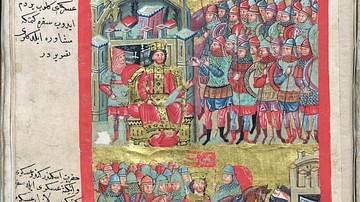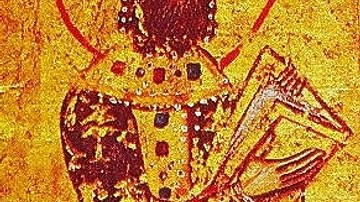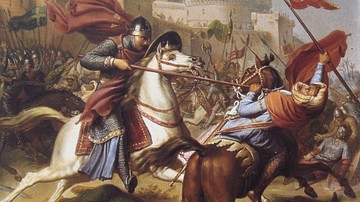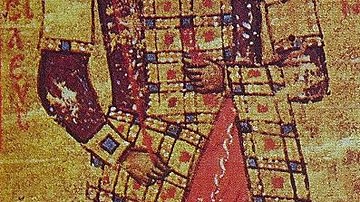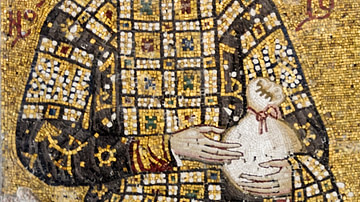
Tamar was the queen of Georgia from 1184 to 1213 CE. She is considered one of the greatest of medieval Georgia's monarchs, and she presided over its greatest territorial expansion, taking advantage of the decline of other major powers in the region. Tamar was the first female monarch of Georgia, and despite initial resistance to a female ruler, her sex helped craft her legacy as Georgia's great medieval queen.
Crowning a Queen
Tamar was the eldest daughter of George III of Georgia (aka Giorgi III, r. 1156-1184 CE). Without any sons of his own, and having blinded and castrated his only nephew after a rebel fomented around him, George had no male heirs. But George made his decision of successor clear, unlike his father Demetrius I of Georgia (aka Demetre I, r. 1125-1156 CE) and grandfather David IV (aka Davit IV, r. 1089-1125 CE), by having Tamar crowned co-monarch in 1178 CE in front of all the Georgian senior aristocracy and clergy.
Tamar then was the nominal co-ruler while George continued to rule for another six years. But when George died in 1184 CE, the nobility made demands of their new queen. First, they insisted that she be recrowned by them, to which she agreed. Next, they demanded that she remove former serfs and foreigners from power, including the powerful Qipchaq general Qubasar, the amirspasalari (commander-in-chief); to this she also agreed. But when they, led by Qutlu Arslan, suggested that the nobility should have the power to appoint government ministers and enact laws, she resisted. Tamar arrested Qutlu and had the rebellious nobles back down when she offered to pardon them.
Tamar also faced resistance from Mikel Mirianisdze, the catholicos (chief bishop) of Georgia. Since the reign of David IV, the catholicos was also the mtsignobarukhutsei (prime minister) of Georgia, which meant he had enormous power. She summoned a synod in 1185 CE to try and overthrow him, but the synod decided to not oppose Mikel, only removing a few hostile bishops from power.
The battle between the aristocracy and clergy versus Tamar came to a fever pitch over her marriage. Many in the kingdom were eager to have Tamar marry so an heir could be secured for the throne. The nobility proposed Yuri Andreyevich Bogolyubsky, a Kievan Rus duke-in-exile. This choice was supported by Catholicos Mikel and Tamar's aunt, Rusudan, who was a powerful figure at court. Yuri was fetched, and the two were wed, with Tamar remaining the ruling monarch. Yuri proved a successful military commander, which was especially valuable because Tamar usually only accompanied the troops partway without leading them into battle. However, the two did not get along well and Yuri was reputedly debauched; in frustration, Tamar requested and was granted an annulment.
Her Own Queen
In 1188 CE, not only was Yuri sent away but Catholicos Mikel also died. Freed from their control, Tamar chose her own men to fill the top positions in Georgia, including interior minister and commander-in-chief. The Mkhargrdzeli brothers, Zakare and Ivane, became especially important as advisors and military commanders. She next married someone of her own choosing: the Ossetian prince David Soslan (also given as Davit Soslan). David was distantly related to Tamar and he had been raised at the Georgian court in Tbilisi, making him an acceptable match, even if Ossetia was not as powerful of an ally as the Kievan Rus could have been. Unlike the one with Yuri, Tamar's marriage with David was a success: they had two children - the future King George IV of Georgia (aka Giorgi IV, r. 1213-1223 CE) and Queen Rusudan (r. 1223-1245 CE) - and the royal couple reportedly balanced each other.
In 1187 CE, Saladin (r. 1174-1193 CE) had retaken Jerusalem from the Crusaders. With Muslim power on the rise again, Tamar sent two diplomatic missions to Saladin which secured the safety of Georgia's Monastery of the Cross and its exemption from taxation in exchange for peace between Georgia and Saladin's state.
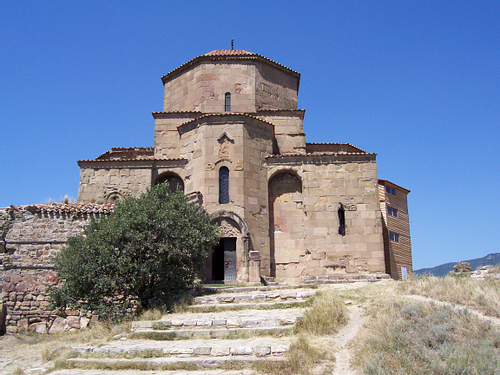
But while peace was secured to the south, war would soon erupt to the west. Yuri, the former husband of Tamar, showed up in Turkish Erzurum. His Georgian supporters, led by Guzan of Tao, came out to greet him and brought him across the border, crowning him king at the royal palace of Geguti. Tamar initially sent negotiators, but then had her loyalist army defeat the rebels in the field. When the rebels surrendered, Tamar showed what became her characteristic mercy: Yuri was sent back to exile in Constantinople; the rebels lost their lands and titles but kept their heads. When Guzan rebelled again, however, David Soslan had him blinded before Tamar could grant him clemency again.
To War
Georgia was once again secure, and in 1192 CE, Tamar gave birth to the future George IV. To celebrate, David Soslan launched two military campaigns, capturing the city of Bardavi, the old capital of Albania in the eastern Caucasus, and Erzurum. In response, the Caliph in Baghdad declared a jihad of all Muslims against Georgia. Nusrat al-Din Abu Bakr, a Muslim ruler of the Eldigüz Dynasty in Azerbaijan, led the attack, occupying Georgia's ally, the Muslim state of Shirvan. Around the same time, Yuri arrived and pledged his loyalty to Nusrat al-Din Abu Bakr.
Yuri was defeated by a Georgian duke in 1193 CE, and thereafter vanishes from the historical record. The main Muslim army under Nusrat al-Din Abu Bakr faced off against David Soslan at the Battle of Shamkor in 1195 CE. David Soslan was victorious, and even the caliphal banners were captured, which were later given by Tamar to the Georgian monastery of Khakhuli. The victorious Georgian army then marched on Ganja, capturing the city and giving it to Amir Mihran, the brother of Nusrat al-Din Abu Bakr, to govern as a Georgian vassal. Nusrat al-Din Abu Bakr had his brother poisoned and managed to recapture Ganja, but the Georgian army marched victoriously south, even capturing the important trading city of Nakhichevan. Although these successes supposedly led Nusrat al-Din Abu Bakr to drink himself to death, Ganja did resist recapture.
Georgia was now at its greatest territorial expanse, which raised the ire of the Seljuk Sultan Rukn ad-Din Süleyman Shah (r. 1196-1204 CE). Süleyman attacked Erzurum and sent a demeaning letter to Tamar, calling her a “simpleton of a queen” and demanding Georgia's surrender. Süleyman offered that if Tamar converted to Islam, he would make her his wife; if not, she would become his concubine. Tamar had a large Georgian army assemble, and David Soslan led it to victory over the several days long Battle of Basiani in 1202 CE. A Muslim counterattack several years later failed and in 1206 CE, Georgian forces occupied Erzurum and Kars.
David Soslan died in 1207 CE, but the Georgian expeditions to the southeast continued unabated. But while Georgia's borders continued to expand, the country did suffer some setbacks: the sultan of Ardabil in Azerbaijan sacked the former capital of Armenia, Ani, on Easter 1209 CE, slaughtering the praying Armenian populace. Georgian forces continued on into Iran, and even the cities of Tabriz and Qazvin offered tribute to Tamar. The loot from this Iranian expedition helped pay for rebuilding Ani.
Aunt Tamar the Empire Builder
While Georgia was victorious in the east, Constantinople had been surrounded by and sacked by the Fourth Crusade in 1204 CE. While the Byzantine Empire was occupied with the Crusaders and then disintegrated into a successor land grab when Constantinople was sacked, Tamar was engaged in a new adventure in Byzantine territory on the Black Sea.
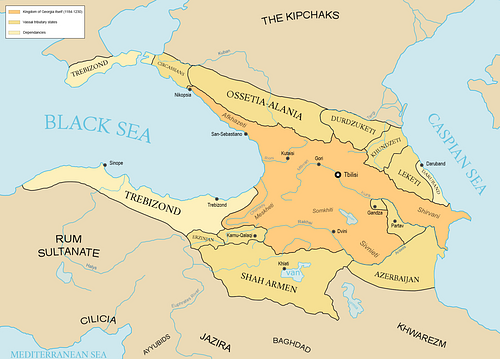
Tamar's sister Rusudan had married Manuel Komnenos, the son of Byzantine Emperor Andronikos I Komnenos (r. 1183-1185 CE). When Andronikos was overthrown in 1185 CE, Manuel and Rusudan's two sons, Alexios and David, were shipped away from Constantinople, the sole survivors of Andronikos' family. Alexios and David were raised at their aunt Tamar's court in Georgia.
When the Byzantine Empire was disintegrating, it appeared an ideal time to help her nephews recapture some of their grandfather's former land. Her Georgian forces helped Alexios and David capture Trebizond and the Black Sea coast up to Sinope. Alexios became Alexios I (r. 1204-1222 CE) of the Empire of Trebizond, which survived as a Byzantine successor state until 1461 CE. The new Empire of Trebizond had strong ties to Georgia and thus expanded Tamar's zone of influence.
Tamar's Legacy
Under Tamar, Georgia reached its greatest territorial and political height. Its armies campaigned from Trebizond to Iran, and Georgia was undisputedly a major power in the region. Tamar is almost certainly the most lauded of Georgia's medieval rulers and was written about and eulogized by Georgians medieval and modern. Contemporary poet Shota Rustaveli's epic, The Knight in the Panther's Skin, is considered a positive allegory of Tamar's reign, and it pointedly notes that “the lion's whelps are equal, be they male or female” (Rustaveli, 39). While there is no historical record of her fighting in battle, the image of Tamar as a warrior queen has also been passed down through Georgian legend as well as images of her as a deity or saint. Tamar was declared a saint by the Georgian Orthodox Church centuries later.
Tamar passed this powerful state to her son, George IV, who seemed poised to continue Tamar's legacy as the leader of a powerful Georgia. Unrest by Georgia's vassals and George's own impulsiveness soured these prospects, but the greatest injury to the legacy of Tamar's Georgia was out of her control: just a decade after her death, the Mongols would arrive in Georgia, and in their wake, the Georgia of Tamar would be but a memory.


